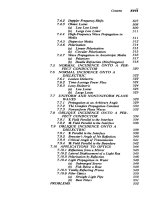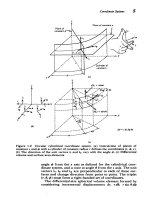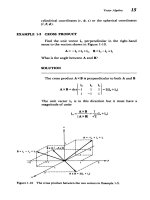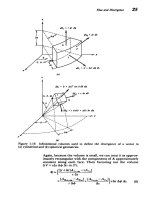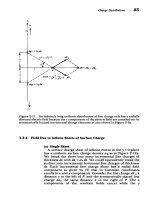Organic reaction mechanism through problem solving approach
Bạn đang xem bản rút gọn của tài liệu. Xem và tải ngay bản đầy đủ của tài liệu tại đây (10.65 MB, 204 trang )
www.pdfgrip.com
Organic Reaction Mechanism
:
Through
Problem Solving Approach
Nitin D. Gaikwad (M.Sc., Ph.D.)
Assistant Professor
Department of Chemistry,
K.T.H.M. College, Nashik-422005
Maharashtra, India
email :
www.pdfgrip.com
Organic Reaction Mechanism:
Through Problem Solving Approach
ISBN : 978-93-5267-423-7
All rights reserved.
No part of this book may be reproduced in any form, byphotostat, microfilm,
xerography or any other means or incorporated into any information retrieval
system, electronic or mechanical, without the written permission of the
copyright owner.
PREFACE
www.pdfgrip.com
This book aims to teach students how to draw organic reaction
mechanism for themselves. Almost all available books, on organic reaction
mechanism describe reactions and their conversions. This book confronts the
student with the organic reaction mechanism by showing how the reagent and
starting molecule act together in the reaction. The reaction mechanism
approach is learnt by students from this book who then teaches themselves
how to use mechanism by solving a series of problems.
It is not a conventional text book with detailed text explanation. In
short this book understand quickly and giving information about reaction
mechanism. Also the student has planned sequence of problems to
demonstrate the use of each new mechanism and to test his understanding of
it. Each problem is followed by possible reaction mechanism and short
explanation, So that if the student fails to solve a problem he will still
understand the answer better for having attempted the problem himself. The
student therefore has the possibility of continuous self assessment through the
use of large number of problems.
There are some excellent books written about organic reaction
mechanism but they mostly present complete synthesis not reaction
mechanism. I have tried in this book to teach student to speak the language of
reaction mechanism themselves. This book is originally written for the first
year students.
The programme aims to allow students to teach themselves but it
shouldn’t mean any less work for them. Because students discover what they
don’t know, they should have more sensible questions to ask when they were
solving reaction mechanism. My aim is to give you more time for real
teaching. The book should do the ground work and you should be able to set
suitable programme and discuss then profitably. The book itself has plenty of
problems of this sort.
www.pdfgrip.com
Though the programme may introduce you reaction mechanism, its
main aim is to suggest a mechanistic approach to the organic reactions. You
therefore need to have a reasonable grounding in organic chemistry so that
you are familiar with most basic organic reactions. If you are first year
student with no much experience of organic chemistry or limited knowledge
of organic reactions in practice you will probably be able to work straight
through the book to learn the actual reaction mechanism. The point of book
learning is that you learn at your own pace and that you yourself check on
your own progress.
www.pdfgrip.com
Contents
1.
2.
3.
4.
5.
6.
7.
8.
9.
10.
11.
12.
13.
14.
15.
16.
17.
18.
19.
20.
21.
22.
23.
24.
Nitration Reaction
Nucleophilic Substitution by NGP
Aromatic Nucleophilic Substitution
Halo-hydroxylation Reaction and Aliphatic Nucleophilic
Substitution
Neighbouring Group Participation by sigma bond
Aromatic Electrophilic Substitution and Diazotization
Aromatic Nucleophilic Substitution
Addition Reaction
Nitration Reaction
Aromatic Electrophilic Substitution
Neighbouring Group Participation by sigma bond
Elimination Reaction with Rearrangement
Rearrangement
Pyrolytic Elimination Reaction
Gattermann Koch Reaction
Pinacol Pinacolone Rearrangement
Alkylation and Dehydration Reaction
Neighbouring Group Participation by heteroatom
Aromatic Nucleophilic Substitution and condensation
Aromatic Electrophilic Substitution
Addition Reaction
Methylation and Vilsmeyer Haack Formylation Reaction
Elimination and Addition Reaction
Aromatic Nucleophilic Substitution
www.pdfgrip.com
25.
26.
27.
28.
29.
Neighbouring Group Participation by sigma bond
Diazotization Reaction with stereochemistry
Friedel Craft Acylation and Condensation Reaction
Addition Reaction: Bromination
Rearrangement
30.
Aliphatic Nucleophilic Substitution and Chlorination by SNi
mechanism
Aliphatic Nucleophilic Substitution
Jacobson’s Reaction
NGP by Aryl ring
31.
32.
33.
34.
35.
36.
37.
38.
39.
40.
41.
42.
43.
44.
45.
46.
47.
48.
Elimination Reaction by E2 Mechanism
Cyclisation by protonation
Cyclisation by using PTSA
Aromatic Nucleophilic Substitution by Elimination –Addition
Mechanism
Diazotization Reaction with stereochemistry
Neighbouring Group Participation by heteroatom and Aliphatic
Nucleophilic Substitution
Friedel Craft Alkylation Reaction and Aromatization Reaction
Riemann Tiemann Reaction
SN2 Mechanism
N-Acylation and Nitration Reaction
Addition Reaction
Aromatic Nucleophilic Substitution by Elimination –Addition
Mechanism and Diazo coupling reaction
Grignard Reaction
Halogenation Reaction and amide formation
Elimination and Addition Reaction
www.pdfgrip.com
49.
Dehydration and Epoxidation Reaction
50.
Aliphatic Nucleophilic Substitution and Chlorination by SNi
51.
52.
53.
54.
55.
56.
57.
58.
59.
60.
61.
62.
63.
64.
65.
66.
67.
68.
69.
70.
71.
72.
mechanism and SN2 Mechanism
Friedel Craft Acylation and Clemmensons Reduction
Nitration ans N-Acylation Reaction
Chlorination with stereochemistry and Elimination Reaction by
Saytzeff rule
Diazotization Reaction with stereochemistry and oxime formation
Hydroboration – Oxidation Reaction
SNi Mechanism
Nitration and Aromatic Nucleophilic Substitution
Halogenation and Nitration Reaction Aromatic Electrophilic
Substitution
Vilsmeyer Haack Formylation Reaction
Friedel Craft Acylation Reaction
Hunds Dicker Reaction
Oxidation and Nitration Reaction
Aldol Condensation Reaction
Epoxidation and Hydrolysis
Vilsmeyer Haack Formylation Reaction
Halogenation Reaction and Neighbouring Group Participation by
Pi bond
Halogenation: Aromatic Electrophilic Substitution
Halogenation: Aromatic Electrophilic Substitution
Methylation and Nitration Reaction
Rearrangement
Diazotisation and Diazo coupling Reaction
Rearrangement
www.pdfgrip.com
73.
74.
75.
76.
77.
78.
79.
80.
81.
82.
83.
84.
Pyrolytic Elimination Reaction
Vilsmeyer Haack Formylation Reaction
Dehydration: Elimination Reaction
Aliphatic Nucleophilic substitution: Chlorination
Cyclisation
Aliphatic Nucleophilic substitution
Aromatic Electrophilic Substitution
Phase Transfer Catalyst
Addition and Elimination Reaction
Methylation , Oxidation and Hydrolysis
Aliphatic Nucleophilic substitution and Reduction
Halogenation: addition Reaction with Stereochemistry
85.
86.
87.
88.
89.
90.
91.
92.
93.
94.
95.
96.
97.
98.
99.
100.
Elimination Reaction (E2)
Alkylation Reaction
Iodination Reaction
Addition Reaction Through Rearrangement
Friedel Craft Alkylation Reaction
Aromatic Electrophilic Substitution
Friedel Craft Acylation Reaction and Bromination reaction
Pyrolytic Elimination Reaction
Sulphonation and Nitration Reaction
Aromatic Nucleophilic Substitution
Nitration and Oxidation Reaction
Sandmeyer Reaction
Pyrolytic Elimination Reaction
Diazotization and Neighbouring Group Participation
Dehydration: Elimination Reaction
Neighbouring Group Participation with Stereochemistry
www.pdfgrip.com
109.
110.
111.
112.
113.
114.
115.
116.
117.
118.
119.
Benzyne Formation
Ortho Nitration reaction
Grignard Reaction
Friedel Craft Acylation Reaction and Clemmensons Reduction
Elimination Reaction
Addition Reaction
Neighbouring Group Participation by Hetero atom and Grignard
Reagent
Elimination Reaction and Neighbouring Group Participation by
Aryl ring
Cyclisation
Nitration Reaction
Dehydration and Elimination Reaction
Elimination Reaction with Stereochemistry
Methylation and o-Nitration
Bromination and Elimination Reaction
Elimination and Epoxidation Reaction
Addition and Cyclisation Reaction
Neighbouring Group Participation by Aryl ring
Pyrolytic Elimination Reaction
Acid Hydrolysis reaction
120.
121.
122.
123.
124.
125.
126.
Elimination Reaction: E2
Aliphatic Nucleophilic substitution and Catalytic Reduction
N-Acylation and Nitration Reaction
Friedel Craft Alkylation, Oxidation and Halogenation
Addition and Rearrangement Reaction
Dehydration and Hydroxylation Reaction
Grignard Reagent and Dehydration
101.
102.
103.
104.
105.
106.
107.
108.
www.pdfgrip.com
127.
128.
129.
130.
131.
132.
133.
134.
135.
136.
137.
138.
139.
140.
141.
142.
143.
144.
145.
146.
147.
148.
149.
150.
151.
152.
153.
Dehydration and Epoxidation Reaction
Elimination and Addition Reaction
Aromatic Nucleophilic Substitution
Friedel Craft Acylation Reaction
Dehalogenation Reaction
Aromatic Electrophilic Substitution
Aliphatic Nucleophilic Substitution
Cyclisation
Neighbouring Group Participation by heteroatom
Aromatic Electrophilic Substitution
Aromatic Nucleophilic Substitution: Elimination Addition
Mechanism
Gattermann Koch Reaction
Benzyne Formation and [4+2] Cyclisation Reaction
Aromatic Electrophilic Substitution
Diazotization and Diazo coupling reaction
Aromatic Electrophilic Substitution
Vilsmeyer Haack Formylation Reaction
Benzyne Formation and Aromatic Nucleophilic Substitution
Alkylation and selective Reduction
Catalytic Reduction and Elimination Reaction
Aromatic Electrophilic Substitution
Wolf Kishner Reduction and Halogenation Reaction
Elimination and Ozonolysis Reaction
Neighbouring Group Participation by heteroatom
Esterification
Aliphatic Nucleophilic Substitution and Reduction
Neighbouring Group Participation by Pi bond
www.pdfgrip.com
154.
155.
156.
157.
158.
159.
160.
161.
162.
163.
164.
165.
166.
167.
168.
169.
170.
171.
172.
173.
174.
175.
176.
177.
178.
179.
180.
181.
Nitration Reaction
Nitration, Reduction and N-Acylation Reaction
Dehydration, Epoxidation and Grignard reagent
Addition Reaction and Cyclisation
Dehydrohalogenation Reaction
O-Acylation Reaction and Cyclisation
Reduction and Sandmeyer Reaction
Chlorination and Aliphatic Nucleophilic Substitution Reaction
Michael Addition and Hydrolysis
Nitration Reaction
Friedel Craft Acylation Reaction
Halogenation and Amide Formation Reaction
Elimiantion and Epoxidation with Stereochemistry
Dehydrohalogenation and Bromination Reaction
Higher Alkyne Formation and Selective Reduction
N-Acylation, Bromination and Deprotection
Cyclisation
Reduction, Diazotisation and Sandmeyer Reaction
Aromatic Electrophilic Substitution
Elimination Reaction
Halogenation, Alkylation and Elimination Reaction
Hydration Reaction and o- alkylation reaction
Iodination and Cyclisation
Friedel Craft Alkylation Reaction
Friedel Craft Acylation Reaction
Nitarion Reaction
Aldol Condensation
Crossed Aldol Condensation
www.pdfgrip.com
181.
1. Nitration Reaction
www.pdfgrip.com
2. Nucleophilic Substitution by NGP
www.pdfgrip.com
3. Aromatic Nucleophilic Substitution
www.pdfgrip.com
4. Halo-hydroxylation
Substitution
Reaction
and
Aliphatic
Nucleophilic
www.pdfgrip.com
5. Neighbouring Group Participation by sigma bond
www.pdfgrip.com
6. Aromatic Electrophilic Substitution and Diazotization
www.pdfgrip.com
7. Aromatic Nucleophilic Substitution
www.pdfgrip.com
8. Addition Reaction
www.pdfgrip.com
9. Nitration Reaction
www.pdfgrip.com
10. Aromatic Electrophilic Substitution
www.pdfgrip.com
11. Neighbouring Group Participation by sigma bond
www.pdfgrip.com
12. Elimination Reaction with Rearrangement
www.pdfgrip.com
13. Rearrangement


